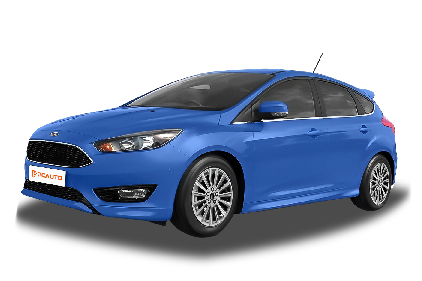Q
Is Ford Focus a compact car?
Yes, Ford Focus belongs to the compact car category, with a vehicle class of C-Segment. It generally has a relatively moderate size. It's suitable for daily urban driving as it's convenient to park, and can also meet certain family travel needs. Take the 2017 Ford Focus Sedan 1.5 EcoBoost Titanium+ for example. It has a length of 4,534mm, a width of 1,823mm, a height of 1,484mm, and a wheelbase of 2,648mm. Such dimensional specifications fall within the range of compact cars.
Meanwhile, it also offers good fuel economy. The official combined fuel consumption is 5.6L per 100km, and the use of advanced fuel technologies helps to improve fuel efficiency. In addition, the interior is well - equipped, providing a comfortable driving and riding experience. Overall, it has a certain competitiveness in the compact car market thanks to its comprehensive performance in terms of handling, configuration, and space.
Special Disclaimer: This content is published by users and does not represent the views or position of PCauto.
Related Q&A
Q
What's the fuel consumption of Ford Focus?
The official combined fuel consumption of the 2017 Ford Focus 4-door sedan with a 1.5-liter EcoBoost engine, Titanium Plus Edition, is 5.6 liters per 100 kilometers. This figure is measured under specific test conditions stipulated by the manufacturer. However, in real-world driving, the actual fuel consumption can vary due to multiple factors.
For instance, driving style has a significant impact on fuel consumption. An aggressive driving style with frequent rapid acceleration and hard braking usually leads to higher fuel consumption, while smooth and constant-speed driving helps save fuel. Road conditions also play a role. Compared with driving on a flat highway with light traffic, driving on hills or in heavy traffic typically increases fuel consumption.
In addition, vehicle load, tire pressure, and the use of accessories such as the air - conditioning system can all affect the actual fuel consumption of the Ford Focus.
Q
What's the service life of Ford Focus' petrol engine?
The service life of the gasoline engine in the Ford Focus can be different. Generally speaking, if properly maintained, the service life of gasoline engine can last for more than 150,000 to 200,000 miles (about 240,000 to 320,000 kilometers) or even longer. The Ford Focus 1.5 EcoBoost Titanium+ is equipped with a 1498 - cc gasoline engine.
Regular oil changes are crucial because fresh oil lubricates the engine components, reducing friction and wear. Replacing filters, such as the air filter and fuel filter, also enables the engine to take in clean air and get the proper fuel mixture. Timely replacement of belts and hoses that age over time helps prevent unexpected breakdowns. Maintaining good driving habits is also important. Aggressive driving with sudden acceleration and hard braking will damage the engine, while smooth driving can extend the engine's service life. Additionally, following the manufacturer's maintenance schedule for the engine (for the Ford Focus, it might be maintenance at regular intervals of mileage or time) can ensure the engine stays in good working condition over the long term.
Q
Which one is better, Honda Civic or Ford Focus?
The Honda Civic and the Ford Focus each have their own advantages, making it difficult to simply judge which one is better. In terms of appearance, the front end of the Ford Focus has a dynamic design. Its large - sized aluminum alloy wheels are well - matched with the sporty taillight group, giving the car an overall fashionable and tech - savvy look. On the other hand, the Honda Civic may have a more simple and smooth shape.
When it comes to the interior, the Focus' 13.2 - inch floating central control screen creates an excellent technological atmosphere. It also comes with a large - sized sunroof, automatic air - conditioning and other complete configurations. The Civic's interior perhaps focuses more on the balance between comfort and practicality.
In terms of power, the Focus offers a variety of power options, including different turbocharged engines, providing plenty of driving fun. The Civic's power performance can also meet the needs of daily driving, and it may perform well in terms of fuel economy.
The prices of the two cars also vary depending on the specific models and configurations. It is recommended that you go to a dealership to test - drive these two models in person, experience their actual driving feelings, and then select the most suitable model for yourself based on factors such as your budget and your preferences for the appearance and interior.
Q
Is Ford Focus smaller than Corolla?
The 2017 Ford Focus Sedan 1.5 EcoBoost Titanium+ measures 4,534mm in length, 1,823mm in width, and 1,484mm in height, with a wheelbase of 2,648mm. The dimensions of the Corolla vary depending on the version and year. Generally, its length ranges from 4,300mm to 4,600mm, width from 1,700mm to 1,800mm, height from 1,450mm to 1,500mm, and wheelbase typically from 2,600mm to 2,700mm. As we can see, the Ford Focus is bigger than the common Corolla in length, width, height, and also longer in wheelbase.
However, the interior space of a car isn't solely determined by its exterior dimensions. Factors such as the in - car layout design also play a role in the actual space experience. Moreover, there are differences in the dimensions among different Corolla models. A detailed comparison requires the accurate parameters of the actual models. But when compared with the above - mentioned models, the Ford Focus has larger overall dimensions.
Q
Which one is better, Mazda 3 or Ford Focus?
Both Mazda 3 and Ford Focus have their own advantages, so which one is better depends on individual needs and preferences. In terms of price, if you have a limited budget, the Focus might be more suitable as it is relatively affordable. When it comes to configuration, the Mazda 3 has more abundant safety features. Even the base - model is equipped with a tire pressure monitoring system and a vehicle stability control system. Regarding power performance, the Focus is powered by a 1.5 - liter naturally - aspirated engine, while the Mazda 3 offers a choice between a 1.5L and a 1.4T engine, and the 1.4T engine provides stronger power. In terms of exterior design, the Focus has a more masculine look, while the Mazda 3 is more appealing to women. Moreover, the seams on the Mazda 3's center console are more delicate. In terms of space, some testers think that the Mazda 3 has a slight edge in headroom and legroom. All in all, if you focus on price and practicality, the Focus is a good option. However, if you prefer rich configurations and strong power, the Mazda 3 may be a better choice.
Q
What is the fuel economy of Ford Focus?
The official fuel consumption of the 2017 Ford Focus sedan 1.5-liter EcoBoost Titanium Plus Edition is 5.6 liters per 100 kilometers. This figure represents the combined fuel consumption under standard test conditions. In real-world driving, the fuel consumption may vary, which can be affected by factors such as driving style, road conditions, and vehicle load. For example, an aggressive driving style with rapid acceleration and hard braking may increase fuel consumption, while a smoother and more stable driving style may make the actual fuel consumption closer to the official data. Additionally, using features such as the air conditioner and having an excessive vehicle load can also affect the car's fuel consumption. The Focus's fuel consumption of 5.6 liters per 100 kilometers makes it a relatively fuel-efficient model in the compact car segment, helping car owners reduce their vehicle usage costs.
Q
Which model of Ford Focus is the best?
As the criteria for "the best" vary from different people, so it's quite difficult to directly determine which model is the best. Take the 2017 Ford Focus Sedan 1.5 EcoBoost Titanium+ as an example. It is equipped with rich configurations. In terms of power, the 1.5 - liter engine has a maximum horsepower of 182PS. The maximum speed can reach 222km/h, and it can accelerate from 0 to 100km/h in 8.6 seconds. Its power output has certain advantages among cars in the same class. Regarding safety features, it is standard - equipped with a series of safety systems such as ABS anti - lock brakes, vehicle stability control, and lane - change assist, and also has six airbags to comprehensively ensure the safety of drivers and passengers. There are also quite a few comfort features inside the car, like the dual - zone automatic air - conditioning in the front row and Sony speakers. However, if consumers pay more attention to fuel economy, its official combined fuel consumption of 5.6L/100km is quite good. If they prefer space, its 421L trunk volume is just average. So, the best model depends on individual's preferences.
Q
Is Ford Focus a small or mid-size car?
The Ford Focus is a small car, specifically a C-segment or compact sedan. It has a body length of 4,534 millimeters, a width of 1,823 millimeters, a height of 1,484 millimeters, and a wheelbase of 2,648 millimeters. These dimensions are typical specifications for a compact sedan. In the automotive classification, compared with mid-size or large vehicles, compact sedans are known for their relatively small size, which makes them easier to be driven in the city.
Compact sedans like the Ford Focus are popular among many consumers for their affordable price, good fuel economy, and easy parking. The Ford Focus is an excellent choice for daily commuting and city driving. And as a compact sedan, it also offers an ample interior space and features, such as a 55-liter fuel tank and 421 liters of trunk space.
Q
How far can a Ford Focus travel on an empty fuel tank?
Generally speaking, it's not recommended to drive your car until the fuel runs out completely, as this can potentially damage components like the fuel pump. However, in theory, if we estimate based on the information of the 2017 Ford Focus Sedan 1.5 EcoBoost Titanium+, its fuel tank capacity is 55 liters, and the official combined fuel consumption is 5.6 liters per 100 kilometers. Calculated at this fuel - consumption level, the theoretical driving range of this car when the tank is full is about 982 kilometers.
However, the actual range is affected by various factors. For example, driving style is an important factor. Frequent hard acceleration and sudden braking increase fuel consumption and reduce the range. Road conditions also play a role. Driving in congested traffic or on mountain roads can cause the fuel consumption to go up. Vehicle load is another factor. Having more passengers or carrying a large amount of items in the car will make it "thirstier" for fuel. So, in actual use, the range of this car will be less than the theoretical value, and the specific figure depends on the actual driving conditions.
Q
What is special about Ford Focus?
The Ford Focus has many distinctive features. It is equipped with a 1.5-liter EcoBoost engine that strikes a great balance between performance and efficiency. The maximum speed can reach up to 222 km/h, and the official 0 - 100 km/h acceleration time is 8.6 seconds. Meanwhile, the official combined fuel consumption is relatively low, at 5.6 liters per 100 kilometers.
In terms of safety, it is equipped with a series of standard features, such as six airbags, an Anti-lock Braking System (ABS), a Vehicle Stability Control system, and a variety of active safety systems. Comfort and convenience are also well - guaranteed. It offers a dual - zone automatic air - conditioning system and a Sony audio system for the front row, along with keyless operation and a single sunroof.
The interior design focuses on ergonomics, creating a "flight cockpit" feel. The 60:40 split - folding rear seats enhance the vehicle's practicality. Moreover, the exterior features a modern and dynamic design with sharp lines, which has won the favor of many consumers.
Latest Q&A
Q
What is the PCD Size of Honda Civic Type R?
The PCD (Pitch Circle Diameter) of the Honda Civic Type R is 5x120. This means its wheels have 5 bolt holes, evenly spaced around a circle with a diameter of 120 millimeters. This specification is similar to many high - performance vehicles and is suitable for pairing with wide wheels and high - performance tires to enhance handling.
For Malaysian car owners, understanding the PCD size is very important. When replacing wheels or upgrading the braking system, it's essential to ensure that the PCD of the new components matches the original factory specifications. Otherwise, adapter flanges may be required, which can affect safety and may not comply with local regulations.
In addition, the center bore diameter of the Civic Type R's wheels is 64.1 millimeters, and the offset (ET) usually ranges from 45 to 55. These figures also influence the selection and installation of wheels.
If you're planning to modify your vehicle, it's advisable to choose certified wheel brands and consult professional technicians to ensure compliance with the requirements of JKR and JPJ while maintaining the vehicle's original performance and safety standards.
Q
What is the Gearbox Type of Honda Civic Type R?
The Honda Civic Type R is equipped with a 6-speed manual transmission. This transmission is specifically tuned for high-performance driving, featuring short-throw shifting and precise clutch feedback. It can fully unleash the power of its 2.0-liter VTEC turbocharged engine, making it an ideal choice for Malaysian drivers who seek driving pleasure.
A manual transmission allows drivers to be more directly involved in power transfer. Moreover, techniques like rev-matching during downshifting can enhance cornering performance. The Type R's transmission comes with a rev-matching function, which reduces jerking during gear changes and is more newbie-friendly.
It's worth noting that the manual transmission still has a loyal following in Malaysia's driving culture, especially among performance car enthusiasts. This is because it offers a purer driving experience. Additionally, the Type R's transmission is designed with daily durability in mind. For example, the synchronizers and gear materials are strengthened to suit the diverse local road conditions.
When compared with other hot hatches in the same class, the Type R's manual setup emphasizes the sense of driving engagement rather than simply chasing shift speed. This distinctive positioning makes it stand out in the Malaysian market.
Q
What Engine is Used in Honda Civic Type R?
The Honda Civic Type R is powered by a 2.0-liter turbocharged four-cylinder gasoline engine with the code K20C1. This engine is well - known for its high performance and reliability. It can deliver a maximum power of 320 horsepower and a peak torque of 400 Nm. Paired with a 6 - speed manual transmission, it offers an extremely fun - to - drive handling experience.
This engine features VTEC (Variable Valve Timing and Lift Electronic Control) technology and is combined with a turbocharging system. This ensures strong torque output at low revs and powerful performance at high revs, making it highly suitable for Malaysia's winding roads and urban driving conditions.
Notably, this engine has undergone special tuning to meet the dual requirements of the Type R model for both track and daily driving, while still maintaining Honda's consistent fuel efficiency.
For Malaysian car enthusiasts, the Civic Type R is not just a high - performance front - wheel - drive hot hatch. It is also an outstanding example of Honda's engineering. Its engine design takes into account both durability and the thrill of driving, making it a perfect choice for local car owners who love to drive.
Q
How Much CC Does Honda Civic Type R Discharge?
As a high-performance hatchback beloved by Malaysian car enthusiasts, the Honda Civic Type R is powered by a 2.0-liter four-cylinder turbocharged gasoline engine with a specific displacement of 1996cc (commonly referred to as 2000cc or 2.0L). This engine can churn out over 300 horsepower in both the FK8 and FL5 generations. Paired with a 6-speed manual transmission, it offers drivers an extremely enjoyable driving experience. For the Malaysian market, the engine displacement of the Civic Type R falls within the range familiar to local consumers. It can not only meet the needs of daily driving but also showcase its high-performance potential on track days.
It's worth noting that although the displacement remains the same, there are upgrades in turbocharging technology, fuel injection systems, and engine tuning for different generations of the Type R. For example, the FL5 version has optimized turbo response and cooling efficiency, which is why it can produce higher horsepower while maintaining the same displacement.
In addition, when Malaysian car enthusiasts choose performance cars, besides paying attention to displacement, they also comprehensively consider the vehicle's suspension tuning, aerodynamic design, and electronic assistance systems. The Civic Type R also performs excellently in these aspects. In particular, its front-wheel-drive chassis tuning is a benchmark in its class and doesn't lose out even when competing with rear-wheel-drive models with larger displacements.
Q
What is the Reslae Value of Honda Civic Type R?
As a high-performance front-wheel-drive sports car, the Honda Civic Type R has shown excellent resale value in the Malaysian used car market. Especially for models in good condition with low mileage, the residual value rate usually remains around 60% to 70% after three years. This is due to the reputation of the Type R series in the sports car field, the scarcity of limited supply, and the recognition of the Honda brand in the local market.
The key factors affecting its second-hand price include the vehicle's maintenance record (it is recommended to keep complete 4S shop repair receipts), whether it has been modified (the original factory state is more preferred), and the body color (classic color schemes such as Championship White hold their value better). At the same time, it should be noted that the FK2 generation before 2017 has less inventory in the right-hand drive market, so it actually has more collection premium space than the subsequent FK8 generation.
For potential buyers, it is recommended to purchase through the certified used car channel on the official website of Honda Malaysia or professional sports car dealers. These channels usually provide additional warranty services. Owners who love track driving need to pay special attention to checking the heat dissipation system and clutch wear. Because the high-rev turbo engine of the Type R places a large load on the cooling system after intense driving, these details will directly affect the valuation when reselling.
View MoreRelated News

Ford Focus will cease production in 2025, shifting strategic emphasis towards electrification
Kevin WongMar 10, 2025

Reviewing the Ford Ranger: The Dual Advantages of Rugged Appearance and Powerful Performance
Kevin WongApr 21, 2025

Ford Unveils “Simulated Manual Transmission” Patent to Reignite Driving Pleasure in Electric Vehicle
LienApr 2, 2025

Which vehicles will make their debut at MOTOR SHOW 2025?
WilliamMar 6, 2025

Tesla's sales champion was taken away by BYD, Model 3 and Model Y lost their sales position in multiple regions
AshleyFeb 26, 2025
View More
















Pros
Cons